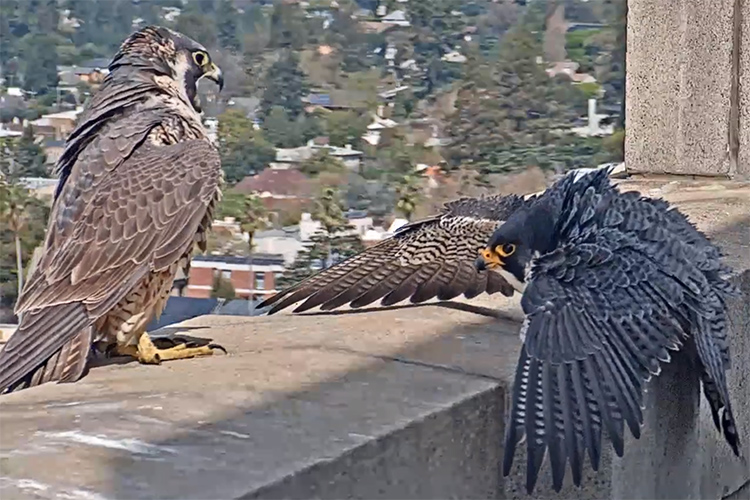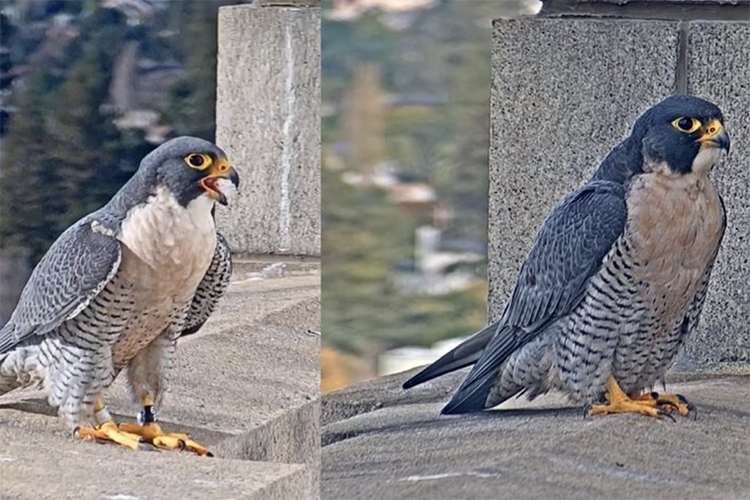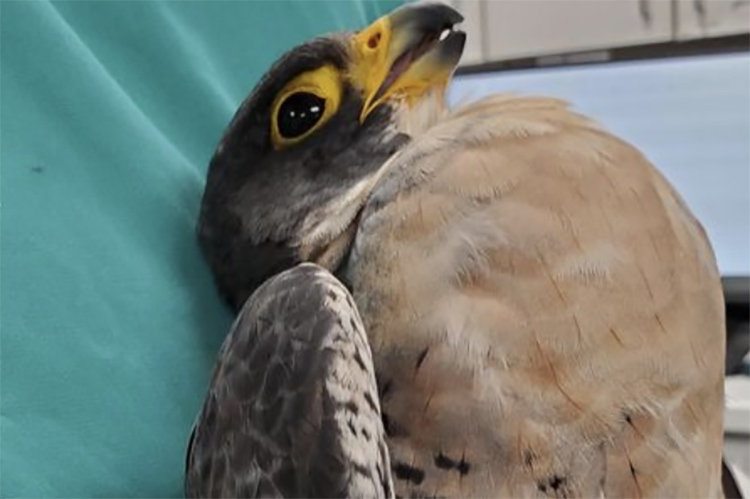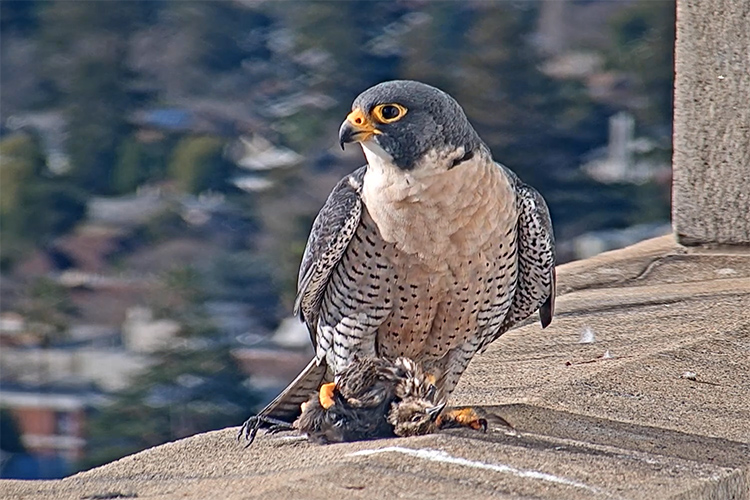As Grinnell heals, ‘soap opera’ in the skies continues at UC Berkeley
Without her mate, who was attacked by rival falcons on Oct. 29, Annie appears to be eyeing a new partner
November 5, 2021

Grinnell (left) has fended off interlopers in the recent past. In this image from March 2020, taken from a Cal Falcons webcam, he faces a falcon invader who’s landed on a ledge of the Campanile, where Grinnell has raised chicks with his mate, Annie, since 2017. (Cal Falcons image)
What will become of Grinnell and Annie, UC Berkeley’s longtime peregrine falcon couple, when Grinnell — injured on Oct. 29 by rival falcons — is released from Lindsay Wildlife Rehabilitation Hospital?
Will Annie, who remains at their nest atop the Campanile, recognize and welcome Grinnell back? Or will a new male, one of the falcons that likely attacked Grinnell and now is lurking about the tower, become her new mate?
Will Grinnell ever return home? And if he does, will he battle the interloper? Will Annie team up with Grinnell for the fight?
These questions — on the minds lately of Annie and Grinnell’s social media fans in more than 40 countries worldwide — dominated a livestreamed Q&A held on YouTube at noon today. It was hosted by Sean Peterson and Lynn Schofield, ornithologists from Cal Falcons, a joint effort by bird experts who represent UC Berkeley, Golden Gate Raptor Observatory, East Bay Regional Park District, the Institute for Bird Populations and the Institute for Wildlife Studies.
Peterson referred to the unfolding drama high above Berkeley’s campus as “the soap opera … at the Campanile,” and Annie, as if on cue, and visible on a tower webcam during the event, drew the 200-plus viewers’ attention by displaying courtship behavior — for the rival.
“She is soliciting pairing behavior with the (new) male, showing she’d be receptive,” said Peterson. But since Annie, like most female peregrine falcons, is larger than the average male peregrine, added Schofield, “he’s still not quite comfortable around her yet. The male is still skittish.”

A side-by-side comparison of Berkeley’s male peregrine falcon, Grinnell (left), before his Oct. 29 injury, and the new male peregrine who likely attacked Grinnell and is now eyeing Annie, Grinnell’s mate on the Campanile. (Cal Falcons image)
Sherrill Cook, owl volunteer species manager and a falcon specialist at Lindsay Wildlife Experience in Walnut Creek, where Grinnell is hospitalized, was a guest at the Q&A session. As dozens of questions from the audience kept the chat box active, she addressed a popular inquiry — Grinnell’s condition.
Found exhausted and injured a week ago on a trash can about a mile and a half from campus, Grinnell didn’t eat for a few days at the Lindsay Wildlife Rehabilitation Hospital and had a “pretty nasty leg injury,” said Cook, plus a wound on his wing that needed sutures, a piece missing from his upper beak, and capillariasis, a disease caused by internal parasites. He’s receiving several types of medication.
The nonprofit has treated more than 300 birds of prey this year, including 17 species of raptors, with red-tailed hawks being the most numerous, followed by Cooper’s hawks.
It’s unknown whether Grinnell was chasing his rivals away or whether they were chasing him.
“When I looked at his record yesterday, he had a little discharge coming out of that (wing) wound, so it’s not healed all the way,” said Cook. “Sutures can come out in two weeks, we’ll check his parasite load early next week, and then we’ll have a better idea where we’re going. To be safe, I’d say he’ll be released in no longer than a month, hopefully, but it could be as short as two weeks. That’s all I can throw out there as a guess.”
Recently, Grinnell ate a quail and had “one of the biggest crops I’d ever seen,” said Cook, speaking of the muscular pouch in a bird’s neck that is a storage place for food. “He decided he was really hungry.”

Grinnell is hospitalized at the Lindsay Wildlife Rehabilitation Hospital in Walnut Creek, where he’s being treated for an injured beak, wing and foot, and for parasites. (Lindsay Wildlife Experience photo by Dr. Krystal Woo)
The piece missing from Grinnell’s injured beak will grow back, said Schofield, adding that falcons need their talons more than their beaks for catching prey.
Meanwhile, back at the nest, Annie has been displaying breeding behavior within view of the male interloper; the female rival has not been around. “If the other female is biding her chance to move in, she’s not making her move,” said Schofield.
And if and when Grinnell returns, the experts said Annie’s not likely to interfere if Grinnell and the male rival fight over her.
“We don’t really know how Annie will respond to (Grinnell) being back in the picture,” said Schofield. “She just may let the males duke it out. Most likely, she’ll stay back from any conflict because she’s most interested in maintaining her territory. She won’t put herself at risk. If she gets caught up in a fight, she might get injured.”
Another question raised was whether Annie will recognize Grinnell when he returns and give him preference over the rival. The pair first arrived at Berkeley in late 2016 and began nesting on the 307-foot-tall bell tower. Schofield said Annie will “definitely recognize Grinnell. Individual falcons can recognize their mates. … and often from a long distance, with just one call.
“If a (new) male comes in and can’t properly care for young, there is some chance that she will make a move in favor of Grinnell. But most likely, she’ll stay out of it.”

In March 2020, Grinnell, in his fourth year as a father falcon, posed with the first of several eggs produced by his mate, Annie. (Photo courtesy of Cal Falcons)
In Grinnell’s favor, he’s been “a very good provider for the chicks he has raised. I’ve been very impressed by his abilities,” said Peterson. Grinnell and Annie have raised 13 chicks over five breeding seasons; one chick died in 2017 while fledging when she hit a window on campus.
Schofield added, “Grinnell does seem to spend more time incubating (the eggs) than the average male falcon does.” Explained Peterson, “Most of the time, the male does the majority of the hunting.”
Even if Grinnell isn’t exactly his old self again after his hospital stay, Schofield said she knows of situations where injured falcons regained their roles as mates and parents after rehabilitation. In one Bay Area nest, she said, a male disappeared for a month and then suddenly returned with a very damaged foot, but was able to raise chicks again. In Minnesota, she added, a male falcon missing several toes on one foot successfully raised a brood of four chicks.
To get birds ready for release, said Cook, Lindsay Wildlife Experience attempts to “get them flight-conditioned. In the case of a peregrine, he can certainly get flight conditioning in one of our large flight aviaries, but if the bird’s turnaround is quick, and we’d like him to get out there (in the wild), … he might not go to the aviary, but straight out, and can get in condition very quickly. It doesn’t take much time to regain muscle tone.”
As for where Grinnell might be released, “I’m actually going to leave that up to Cal Falcons and the Predatory Bird Research Group (at UC Santa Cruz),” said Cook.

Grinnell has been “a very good provider for the chicks he has raised. I’ve been very impressed by his abilities,” said Sean Peterson, an ornithologist with Cal Falcons, in a livestreamed Q&A on Nov. 5, 2021. (Cal Falcons image)
There’s no doubt that, wherever he’s let go, Grinnell will be able to find his way home.
“If Grinnell wants to go back to his territory,” said Peterson, “he’ll go back. Falcons have an unbelievable navigational ability to go back to places they know.”
Right now, said Schofield, Cal Falcons’ preliminary thought is to release him by the Lawrence Hall of Science, within view of the Campanile, but at a distance.
“We thought Grinnell would be able to see his territory and assess whether he wants to engage, or decide it’s no longer his, and that it’s better for him to find a new place to go,” said Schofield. “But I don’t think we’ve settled on that. The Predatory Bird Research Group will be the final word on that.”
Cook said that Lindsay Wildlife Experience once released an adult female, who had lost her home, about 20 miles from where she was rescued, and she “found her way back and fought with the female who had taken over her territory.”
Meanwhile, the falcon drama continues at Berkeley, with Annie being relatively receptive to a new and apparently younger male. The interloper is at least 2 years old, according to Cal Falcons, while Grinnell is 8, and Annie is estimated to be around age 7.
“I don’t think wild animals tend to dilly-dally and wait around … Annie might not wait around,” said Peterson.
Yes, peregrines generally mate for life, keeping the same partner from year to year, said Cook, but “life throws a lot of curves. If one mate goes missing, sometimes interlopers come in, and the mated pair for life is no longer a pair.”